Abstract
1. The 37 amino acid human calcitonin gene-related peptide (CGRP), was injected intra-arterially into the isolated, blood perfused spleen of the dog. 2. The only vascular response observed to CGRP, once threshold had been reached (10-20 fmol), was a dose-dependent splenic arterial vasodilatation. 3. The mean intra-arterial bolus dose of CGRP to reduce the splenic arterial vascular resistance by 50% of maximum response was 0.52 +/- 0.12 pmol. This value was significantly lower than the ED50 for the non-selective beta-adrenoceptor agonist isoprenaline (P less than 0.01) in the same experiments. CGRP is the most potent splenic vasodilator yet tested. 4. The mean maximum vasodilator response to CGRP was significantly less (P less than 0.001) than that achieved with isoprenaline. 5. The time course of the splenic arterial vascular response to CGRP was substantially longer than that to isoprenaline. 6. The splenic vasodilator response to CGRP was not altered by the prior administration of the selective beta 2-adrenoceptor antagonist, ICI 118,551. 7. At all doses of CGRP that caused splenic vasodilatation there were substantial increases in spleen volume. The time course of the response and slope of the regression line suggested an active capsular relaxation component. 8. In view of its location within the spleen and high molar potency, CGRP may be considered as a potential factor in the local control of the circulation through the spleen.
Full text
PDF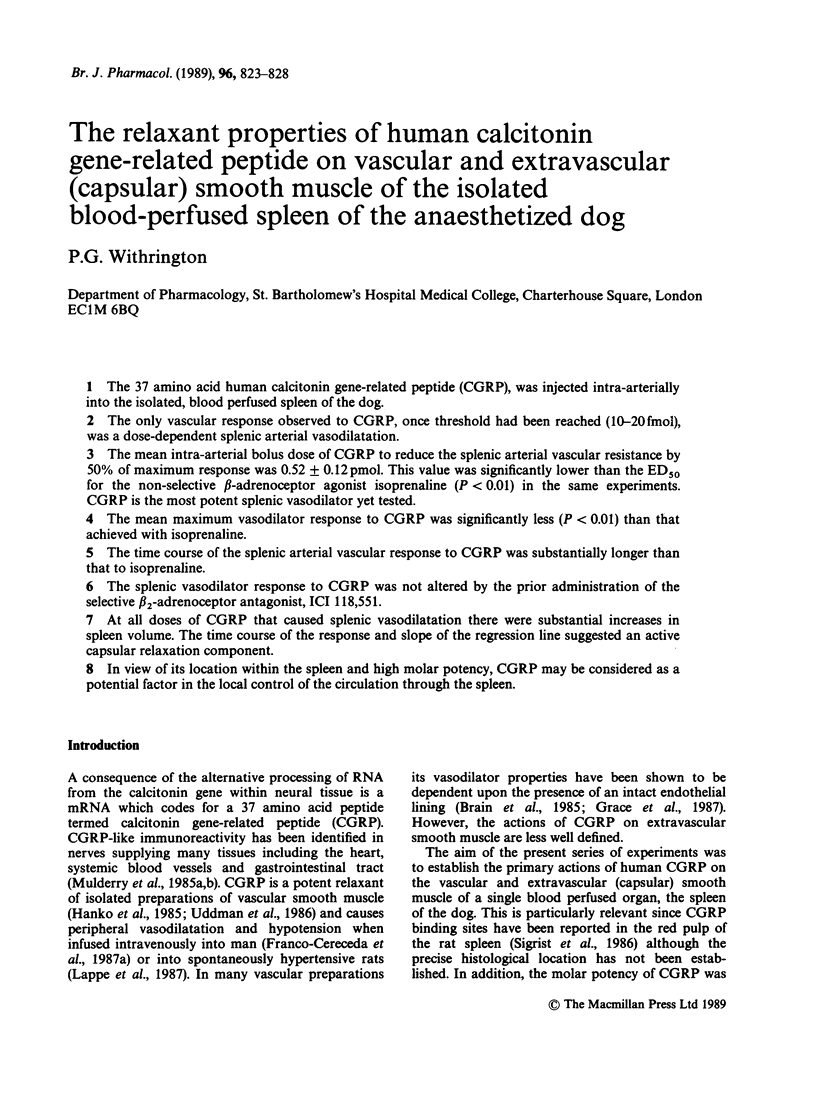
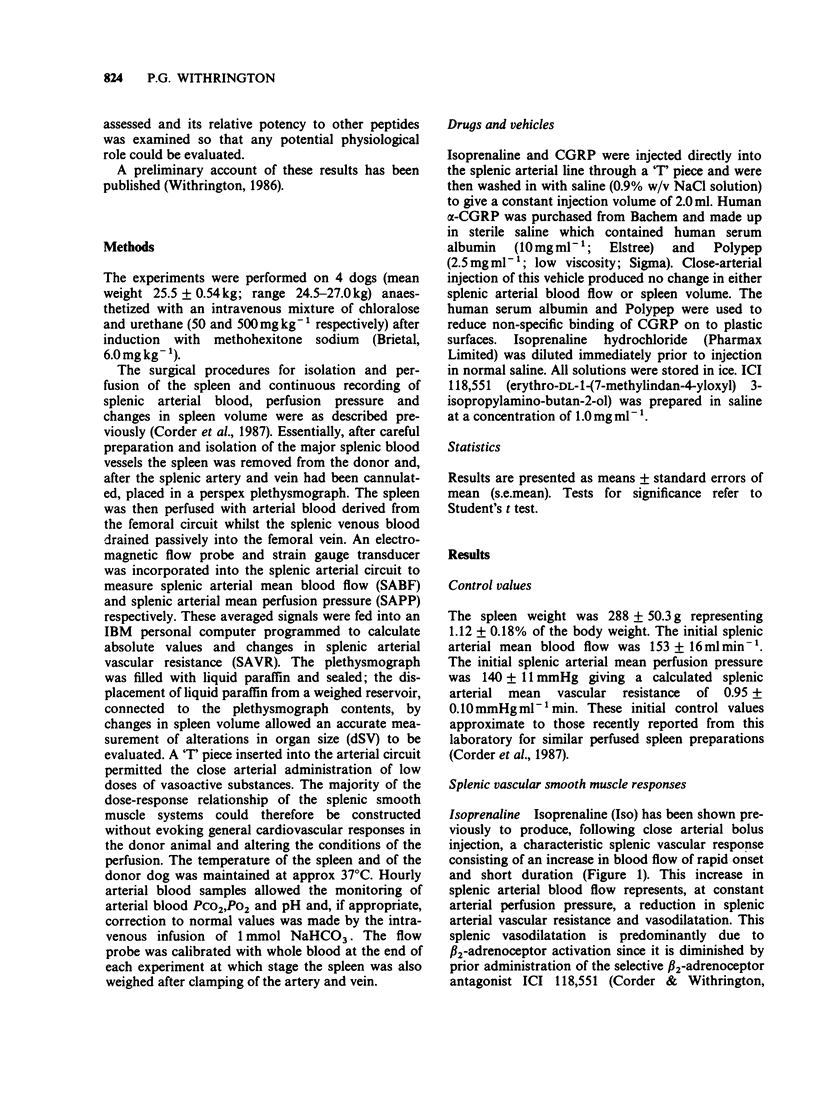
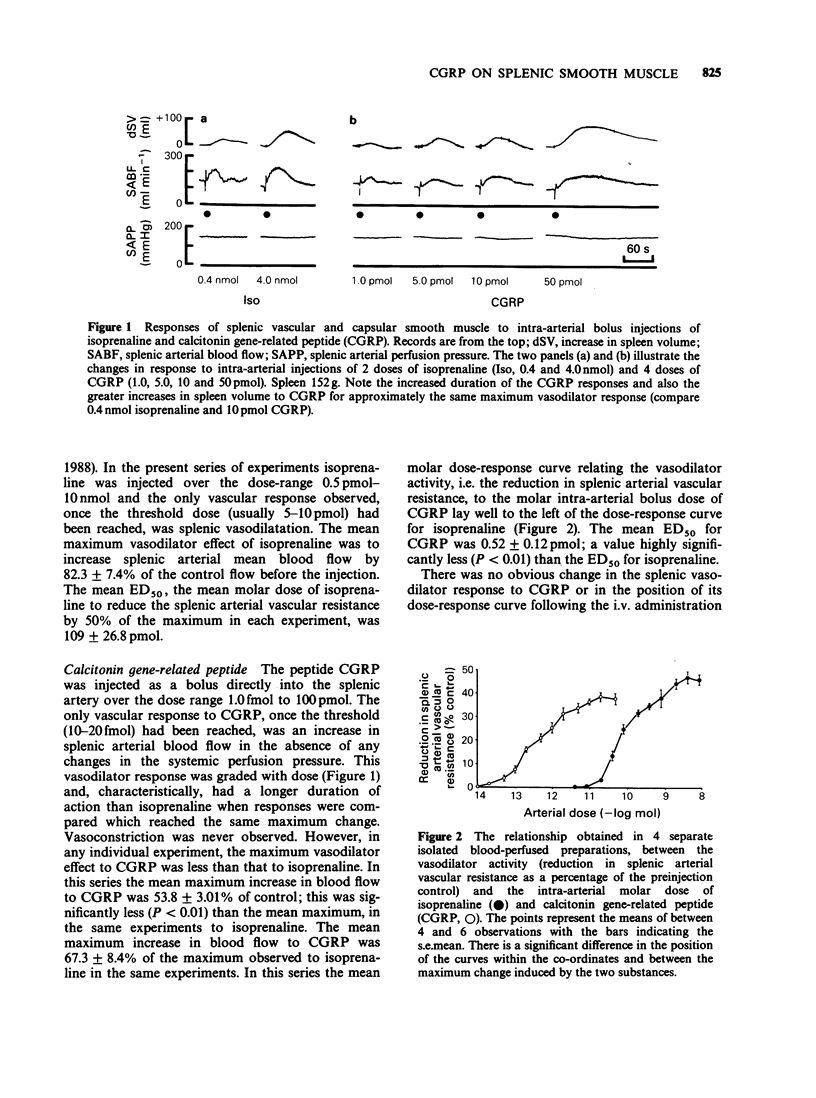
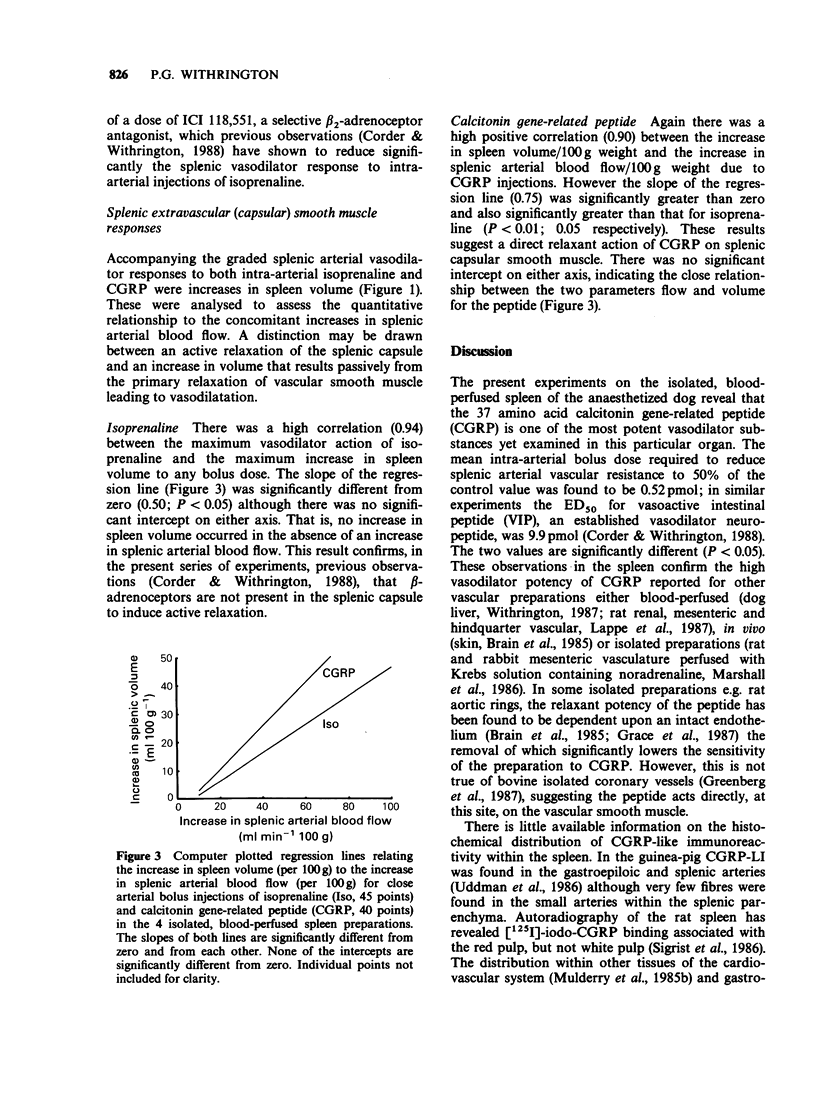
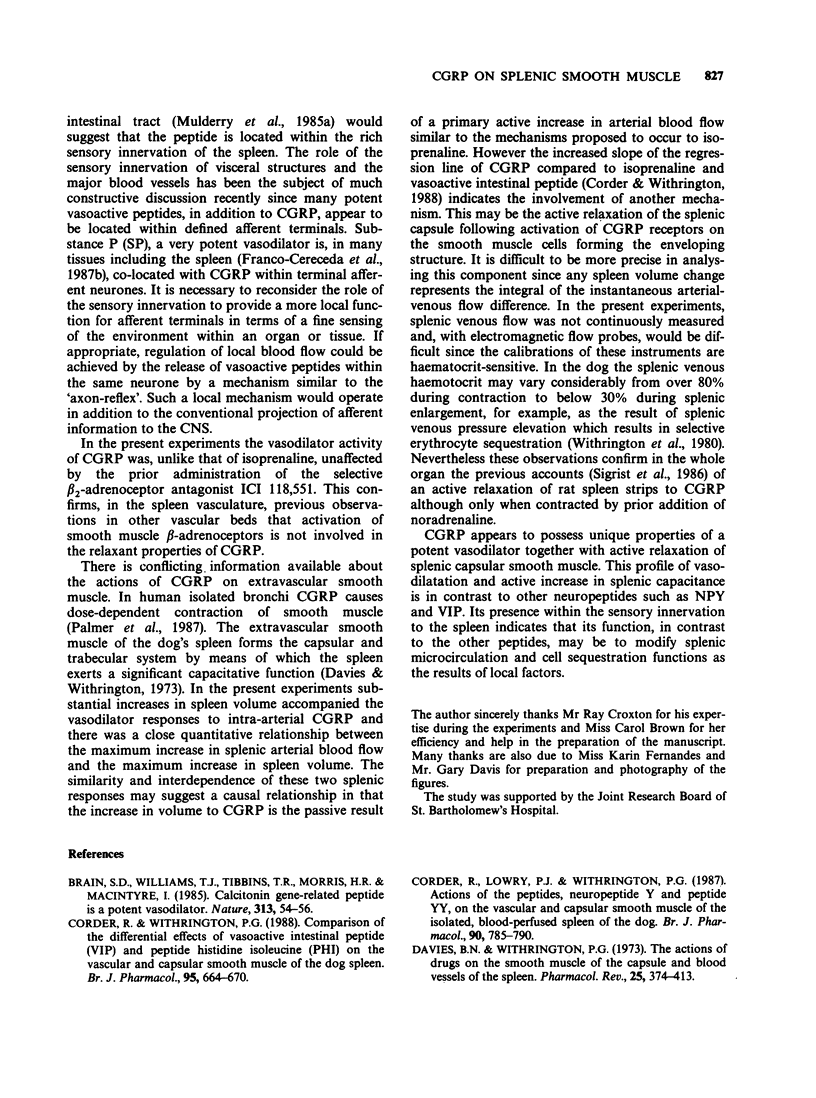
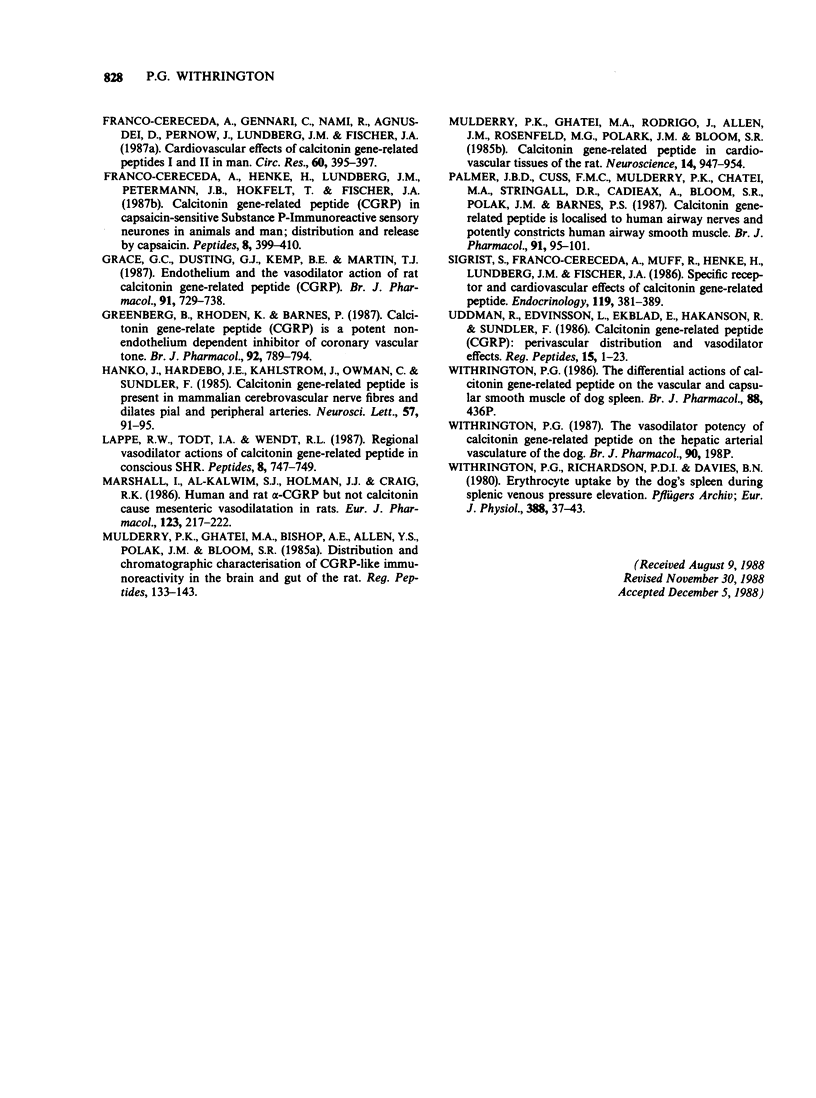
Selected References
These references are in PubMed. This may not be the complete list of references from this article.
- Brain S. D., Williams T. J., Tippins J. R., Morris H. R., MacIntyre I. Calcitonin gene-related peptide is a potent vasodilator. Nature. 1985 Jan 3;313(5997):54–56. doi: 10.1038/313054a0. [DOI] [PubMed] [Google Scholar]
- Corder R., Lowry P. J., Withrington P. G. The actions of the peptides, neuropeptide Y and peptide YY, on the vascular and capsular smooth muscle of the isolated, blood-perfused spleen of the dog. Br J Pharmacol. 1987 Apr;90(4):785–790. doi: 10.1111/j.1476-5381.1987.tb11232.x. [DOI] [PMC free article] [PubMed] [Google Scholar]
- Corder R., Withrington P. G. A comparison of the differential effects of vasoactive intestinal peptide and peptide histidine isoleucine on the vascular and capsular smooth muscle of the dog spleen. Br J Pharmacol. 1988 Oct;95(2):664–670. doi: 10.1111/j.1476-5381.1988.tb11689.x. [DOI] [PMC free article] [PubMed] [Google Scholar]
- Davies B. N., Withrington P. G. The actions of drugs on the smooth muscle of the capsule and blood vessels of the spleen. Pharmacol Rev. 1973 Sep;25(3):373–413. [PubMed] [Google Scholar]
- Franco-Cereceda A., Gennari C., Nami R., Agnusdei D., Pernow J., Lundberg J. M., Fischer J. A. Cardiovascular effects of calcitonin gene-related peptides I and II in man. Circ Res. 1987 Mar;60(3):393–397. doi: 10.1161/01.res.60.3.393. [DOI] [PubMed] [Google Scholar]
- Franco-Cereceda A., Henke H., Lundberg J. M., Petermann J. B., Hökfelt T., Fischer J. A. Calcitonin gene-related peptide (CGRP) in capsaicin-sensitive substance P-immunoreactive sensory neurons in animals and man: distribution and release by capsaicin. Peptides. 1987 Mar-Apr;8(2):399–410. doi: 10.1016/0196-9781(87)90117-3. [DOI] [PubMed] [Google Scholar]
- Grace G. C., Dusting G. J., Kemp B. E., Martin T. J. Endothelium and the vasodilator action of rat calcitonin gene-related peptide (CGRP). Br J Pharmacol. 1987 Aug;91(4):729–733. doi: 10.1111/j.1476-5381.1987.tb11270.x. [DOI] [PMC free article] [PubMed] [Google Scholar]
- Greenberg B., Rhoden K., Barnes P. Calcitonin gene-related peptide (CGRP) is a potent non-endothelium-dependent inhibitor of coronary vasomotor tone. Br J Pharmacol. 1987 Dec;92(4):789–794. doi: 10.1111/j.1476-5381.1987.tb11382.x. [DOI] [PMC free article] [PubMed] [Google Scholar]
- Hanko J., Hardebo J. E., Kåhrström J., Owman C., Sundler F. Calcitonin gene-related peptide is present in mammalian cerebrovascular nerve fibres and dilates pial and peripheral arteries. Neurosci Lett. 1985 Jun 4;57(1):91–95. doi: 10.1016/0304-3940(85)90045-x. [DOI] [PubMed] [Google Scholar]
- Lappe R. W., Todt J. A., Wendt R. L. Regional vasodilator actions of calcitonin gene-related peptide in conscious SHR. Peptides. 1987 Jul-Aug;8(4):747–749. doi: 10.1016/0196-9781(87)90052-0. [DOI] [PubMed] [Google Scholar]
- Marshall I., Al-Kazwini S. J., Holman J. J., Craig R. K. Human and rat alpha-CGRP but not calcitonin cause mesenteric vasodilatation in rats. Eur J Pharmacol. 1986 Apr 16;123(2):217–222. doi: 10.1016/0014-2999(86)90662-x. [DOI] [PubMed] [Google Scholar]
- Mulderry P. K., Ghatei M. A., Rodrigo J., Allen J. M., Rosenfeld M. G., Polak J. M., Bloom S. R. Calcitonin gene-related peptide in cardiovascular tissues of the rat. Neuroscience. 1985 Mar;14(3):947–954. doi: 10.1016/0306-4522(85)90156-3. [DOI] [PubMed] [Google Scholar]
- Palmer J. B., Cuss F. M., Mulderry P. K., Ghatei M. A., Springall D. R., Cadieux A., Bloom S. R., Polak J. M., Barnes P. J. Calcitonin gene-related peptide is localised to human airway nerves and potently constricts human airway smooth muscle. Br J Pharmacol. 1987 May;91(1):95–101. doi: 10.1111/j.1476-5381.1987.tb08987.x. [DOI] [PMC free article] [PubMed] [Google Scholar]
- Sigrist S., Franco-Cereceda A., Muff R., Henke H., Lundberg J. M., Fischer J. A. Specific receptor and cardiovascular effects of calcitonin gene-related peptide. Endocrinology. 1986 Jul;119(1):381–389. doi: 10.1210/endo-119-1-381. [DOI] [PubMed] [Google Scholar]
- Uddman R., Edvinsson L., Ekblad E., Håkanson R., Sundler F. Calcitonin gene-related peptide (CGRP): perivascular distribution and vasodilatory effects. Regul Pept. 1986 Aug;15(1):1–23. doi: 10.1016/0167-0115(86)90071-6. [DOI] [PubMed] [Google Scholar]
- Withrington P. G., Richardson P. D., Davies B. N. Erythrocyte uptake by the dog's spleen during splenic venous pressure elevation. Pflugers Arch. 1980 Oct;388(1):37–43. doi: 10.1007/BF00582626. [DOI] [PubMed] [Google Scholar]


